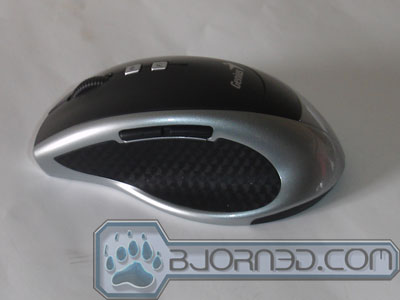Have you ever considered the environmental waste from all of the disposable batteries you throw away from your wireless mouse? The DX-ECO from Genius has an ingenious solution to this problem. The DX-ECO uses capacitors as opposed to conventional batteries to store a charge. This makes the mouse extremely light and have a recharging time of only 4 minutes.
INTRODUCTION
We’ve always liked wireless mice because we hate dealing with the tangled wires. However, we also hate the fact that all wireless mice are heavy due to the need for a battery. Making the matter worse, many wireless mice do not come with rechargeable batteries, meaning users have to carry spare batteries around wherever they take the mouse.
When we first heard of the totally battery-free mouse from Genius, we were intrigued. We asked for a sample and they were kind enough to provide one for us.
Despite its marketing label, like any electronic device, the DX-ECO still needs a power source to keep it running. The difference here is that instead of the traditional electrochemical cell that is widely used in a typical AA or AAA battery, the mouse uses a capacitor to store the energy. As a result of this, the mouse is much lighter than your typical wireless mouse and the charge time is dramatically reduced. We think there is a very big potential for what Genius has done here. The Genius DX-ECO costs around $40 online.
The DX-ECO

The DX-ECO is packaged in a clear see through plastic where we can get a glimpse of the mouse in all of its glory. Luckily, the folks at Genius did make the plastic packaging very easy to open as it is not heat sealed so there is no need for a knife, and the unboxing is relatively painless.

The DX-ECO comes with:
- Manual
- Micro USB cable
- Mouse
- Mini USB receiver
Many wireless devices now shipped with a mini USB receiver that is no larger than the USB connector. What is a little odd here with the DX-ECO is that the gold contact points on the USB connector are exposed, leaving the possibility of them being damaged. It is unlikely that anyone would eject the receiver multiple times or carry it in their pocket routinely, so unlike a USB flash drive that can easily be damaged while being carried around, the exposed contact points will probably not be a major issue for most people. The mouse connects to the receiver via 2.4 GHz radio frequency. Personally, we would prefer if the mouse use Bluetooth connectivity. However, many laptops out there do not have Bluetooth built in, so the use of the USB receiver rather than Bluetooth makes it portable and more available. Additionally, it would free up one USB port. Since the mouse uses a USB cable for charging, you technically need two USB ports (one for the receiver and one for charging). Of course, the charging cable can be disconnected once the mouse is charged.


The DX-ECO is not the most flashy mouse on the market or packed with tons of button, as it is not designed for gaming. It is very plain looking with its black and silver exterior. The color is subdue with black and silver. As it is marketed toward working environment and not gamers, the plain color should blends in well in any working environment. The mouse is designed for right-handed users only so lefties are out of luck. The slight curved body of the mouse is comfortable on our hand and has a good ergonomic.
There are a total of 7 buttons on the mouse. In addition to the typical left, right, and scroll, there are two additional buttons located on the left side thumbrest, for forward and backward. The main left and right buttons are easy to reach. The two buttons located next to the thumb for back and forward are quite large. The forward button is just right next to the thumb but the back button is a tad closer to the rear of the mouse so that it needs a little bit more movement. All of the buttons are fairly easy to press with a distinctive clicky feel to them.
Sitting right above the scroll wheel is where we find the two extra buttons. One of them is for DPI change. The DX-ECO has two DPI settings: 800 and 1600. There is no intermediate setting between the two which is unfortunate. We feel 800 is a little bit too slow and 1600 can be a tad too fast for some people. The 1600 DPI feels comfortable for our 27’’ display at 2560×1440 resolution but if you if you are using a screen with a lower resolution, you might need a little time to adjust the faster movement.
Just above the scroll wheel is what Genius called “Flying Scroll”, which is really nothing more than continuous scrolling. If we hold down the button and move the mouse up and down or left and right, we were able to continuously scroll in any application. Initially, we thought this maybe a little redundant but after using it a little bit, we found it to be quite useful especially for a long documents like webpages or spreadsheets. The button also allows left and right panning as well. However, unlike the up and down, the direction is reversed. If we move the mouse to the right, we are panning to the left and if we move to the left, it pans to the right. One little drawback is that we had to hold down the button and move the mouse at the same time in order for the scroll and panning to work. There is no way to press it once to lock to the scroll mode and press it again to unlock the scroll mode. The included software provides us a tool to adjust the number of lines to scroll at a time, and even offers the option to scroll one screen at a time.
The DX-ECO scroll-wheel has a very subtle clicky feeling that we know some people may hate. It is not a smooth scroll like the Logitech mouse and you can definitely feel the wheel is scrolling. However, it does not make the scrolling noise that you often hear, so it’s a plus if you are looking for a quiet mouse. We did not have to apply much force to the scroll wheel to move it up and down and we personally like a little friction with the scroll wheel so we have a better control of the scrolling.

The upper face plate for the DX-ECO can be removed. Pressing the tab on the rear of the mouse ejects the cover off the mouse. Inside we find a holder for the mini USB receiver. This may come in handy if you like to bring your mouse with you while on a trip. However, the cover is quite filmy and putting it back to the mouse takes some work to align the cover to properly. Personally, we suggest not taking the cover off too often as we feel that it can easily be snapped.
To charge the mouse, simply plug in the included mini-USB cable to the mouse and hook up the other end to the USB port and you are ready to go. The charging time is astonishingly fast. It takes about 3 minutes to fully charge the device (yes, minutes). This will certainly be appreciated as one full charge only lasts about 4 hours of continuous use. We do wish the internal battery could last at least eight hours for a full day of work without the need to recharge the mouse two to three times a day. However, with a 3 minute charge time, the low battery life is forgivable. Additionally, the mouse is fully functional while it is attached to the USB cable. However, the cable easily falls off the mouse as it lacks any lock mechanism. Any slight movement will dislodge it.
Genius rates the capacitor inside the DX-ECO to have a lifespan of 100,000 charges. If we work 8 hours a day, it would mean that the mouse needs to be charged twice a day and 730 times a year. This works out a lifespan of about 136 years. Even if we double the number of charges, we still get about 50 years, well into the lifespan of the mouse.
The mouse uses BlueEye technology to allow the unit to work across various virtually any surface like dusted glass, marble, carpet, and sofa. We tested the mouse on wooden desk, black metal, and carpet, the mouse operated without any issue. It does have a little bit of trouble with clear surfaces like the glass or transparent acrylic, though this is common with any optical mouse. The feet appear to be made of plastic as opposed to rubber but they don’t affect the movement of the mouse, as it glides over surfaces without much issue.
The software that is included has a very plain-looking but it nonetheless gets the job done. All of the essential functions are here. We can also adjust the double-click speed, vertical scrolling and horizontal scrolling speed, and the mouse movement speed. Oddly enough, the software provides a greater speed adjustment than the two DPI settings but it is not labelled so we were not sure what DPI settings are provided with the software. When we pressed the DPI switch on the mouse the software setting also did not change so we are not even sure if the software overrides the DPI setting on the mouse.
With the exception of the DPI switch and left and right-click buttons, the rest of the buttons can be customized to serve different functions. Users can use the buttons to launch applications, open a specific folder, close application, maximize or minimize the screen, and others. It can also be used to map specific settings in web browser, office application, media playback software, or e-mail application. For example, the buttons can be mapped to control media playback to play the next track, pause, volume up or volume down. You can also map it to use copy, paste, or save in office applications. In email, you can set it to create a new email, reply an email, or forward an email. Essentially, most commonly repeated tasks can be assigned, and so on.
Conclusion
It has been a long time since we have seen fundamental changes in the way mice are designed. We are not sure if the Genius DX-ECO is the first mouse that uses capacitors to store the charge for a wireless mouse but we do hope that other mouse manufacturers will implement such technology into their devices. Using capacitors to store the charge allows the mouse to be extremely light and it also reduces the recharging time to a few minutes as oppose to hours. All things considered, the DX-ECO is a good mouse to be used in a mobile-office environment. The only thing that we really like to see at least eight hours of battery life so it can last a whole day of work.
| OUR VERDICT: Genius DX-ECO | ||||||||||||||||||
|
||||||||||||||||||
| Summary: The DX-ECO mouse from Genius offers an innovative twist to the way wireless mice are designed. We would like to see a longer battery life and a more secure charging cable, but overall, it is a great product. With a charging time of three minutes and a very portable design, the Genius DX-ECO earns the Bjorn3D Seal of Approval. |
 Bjorn3D.com Bjorn3d.com – Satisfying Your Daily Tech Cravings Since 1996
Bjorn3D.com Bjorn3d.com – Satisfying Your Daily Tech Cravings Since 1996















